Ontario’s minimum wage falls short of a decent “livable” wage
The province has announced that effective January 1, 2022, the minimum wage will increase to $15 per hour. Currently, the rate is $14.35 per hour. Depending on where you live in Ontario, those earning minimum wage – the amount employers must pay by law – may not make enough to afford “living” in the community they call home.
Critics argue that the wage hike is an election ploy and that the increase should have occurred three years ago. In October 2020, the minimum wage increased from $14 per hour to $14.25 per hour. Prior to that, the provincial minimum wage had not changed since January 2018 when the rate increased from $11.60/hr to $14/hr.
The Ontario Living Wage Network (OLWN), a policy-based organization working to change policy and self described as “a network of employers, employees, non-profits, researchers, and proponents of decent work standards for all Ontario workers”, suggests how much a person should earn in order to cover the actual costs of living in their community.
The formula to calculate a living wage involves a series of metrics including the cost of things like food, shelter, clothes, child/medical care, transportation and recreation. Things like changing demographics and inflation also factor into the living wage calculations.
Not surprisingly, Toronto is considered one of the most expensive cities in which to live. According to the 2021 OLWN rates, Toronto, at $22.08/hr, is the region requiring the highest rate to live a decent life. That is nearly eight dollars above the current minimum wage.
Based on a 40-hr work week, a person earning minimum wage ($15/hr), earns about $31,200 (gross) per year. In order for a person to earn a “livable” wage ($22/hr), in Toronto, that same person would earn $45,800 per year, which is $3,500 per month or $800 per week.
To put things into perspective, the average cost of a one-bedroom rental in Toronto is just over $1,900, per month, according to Rentals.ca, October 2021 Rent Report. That level of rent, leaves only about $1,600 per month to cover other necessities like food, transportation, clothing, insurances, bills, etc.
Next on the list is Halton region, which includes Burlington, Oakville, Milton and Halton Hills. It has the second highest liveable wage requirement at $20.75/hr.
Peel region, which encompasses Brampton, Mississauga and Caledon sits in third place for a living wage, at $19.80/hr. Critics maintain that the cost of living continues to rise and wages have not kept pace.
They argue that it is becoming increasingly difficult for some individuals to make ends meet. For instance, the 2018-2028 Peel Poverty Reduction Strategy report suggests that 12.8% of Peel’s population live in poverty and more than 50% of neighbourhoods are considered to be low income.
On the lower end of the scale is Sault St. Marie where a liveable wage requirement is only $16.20/hr.
As the wealth gap widens, the increase to Ontario’s minimum wage appears to be a good start to help mitigate the economic disparities among lower income communities. However, the ‘working poverty’ problem persists making it more challenging for the working class to earn a “livable” wage.




